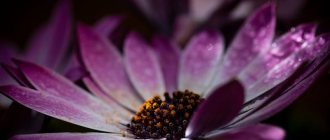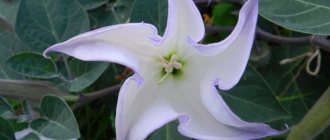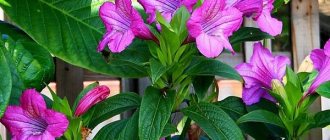Acidanthera is a bulbous plant that captivates at first sight with its grace and elegant flowering. People call it “fragrant gladioli” because it is a little similar to hybrid gladioli and resembles them in its subtle aroma. Growing and caring for this flower is in many ways similar to the agricultural techniques for growing bulbous flowers at home.
Acidanthera is used as an open ground plant, a tub crop for decorating a yard or balcony. In addition, people often force this flower for March 8 or other holidays that fall during the cold season. Since it is easier to do this than to grow hyacinth by a certain date, amateur gardeners are increasingly paying attention to it.
Description
The plant belongs to the iris family, genus gladiolus, species – gladiolus Muriel. More recently, it was classified as an independent genus Acidanthera, so in the literature one can sometimes find discrepancies. The bulbous acidanthera flower received its foreign name in honor of Lady Muriel Agnes Stewart Erskine (1879-1967), who belonged to one of the oldest families in Scotland.
The herbaceous plant has a corm. Suitable for open and closed ground. The height of an adult specimen can reach 1 meter. The leaves are sword-shaped, wide, up to 60 cm long. Each bulb has two leaves, but usually the plants are grown in groups. Peduncles are long, thin, up to 1.5 meters high. The flowers are quite large, from 5 to 8 cm in diameter, soaring, collected in an inflorescence of up to 10 flowers. The outer part of the petals is snow-white, closer to the base there is a contrasting spot, the color of which can vary from dark crimson to inky purple or almost black. The flower has the shape of a butterfly, the petals are very pointed at the ends.
Blooms in late summer-early autumn, depending on planting time.
For your information! Sometimes flower growers wonder why fragrant gladiolus does not smell. The strength of the smell varies from species to species; the aroma can be light, barely noticeable. But, in any case, the fragrant gladiolus produces a scent, unlike ordinary gladioli. The smell is not strong, but very pleasant and original, slightly reminiscent of jasmine. Attractive to bees. There is a hybrid of adidanthera and gladiolus, called gladanthera - it has a weaker smell.
Features of the plant
- Acidanthera Muriel is a small perennial plant no more than one and a half meters. The tubers are white, round, bulbous. The diameters are about thirty millimeters with a hard protective film of light brown color.
- At the top of the trunk the shoots are branched. Linear or sword-shaped leaves are large, green, reaching one and a half meters.
- The inflorescences resemble a spike and usually contain from three to ten flowers of a light powdery color, up to fifteen centimeters. The buds exude a pleasant sweetish aroma, a treat for bees. The flowers have an elongated tube, with six sharp petals of a gradient color.
- There are crimson, purple with an almost black base. Flowering period late summer early autumn.
- The buds open one by one from bottom to top; this feature allows the flowering period to be considered to be about four weeks. Fruit boxes are filled with seeds.
Selection and pre-planting treatment of bulbs
It is better to buy planting material in domestic nurseries; Dutch bulbs may be too tender.
How to store acidanthera bulbs before planting? Before planting, disassembled bulbs are treated with fungicides to avoid further damage by root rot and kept at a temperature of +22°C for 2 weeks.
Immediately before planting, it makes sense to soak the bulbs for several hours in any growth stimulant (Epin, Zircon).
Preparing acidanthera for winter
After flowering ends, the tubers are prepared for the upcoming winter. To do this, cut off the top part and remove faded inflorescences. You need to dig the bulbs out of the ground before the onset of winter frosts. The optimal time for digging is the beginning - mid-October. For regions where cold snaps occur earlier, flower growers recommend removing corms from mid-September. For regions with a mild, warm climate, it is not necessary to dig up acidanthera for the winter. With the arrival of autumn, the soil is mulched with peat or straw, spruce branches, and cardboard are placed on the flowerbed. With the arrival of spring, the shelter is removed and caring for the plants continues according to the above scheme.
Digging is carried out with extreme caution so as not to injure the bulb with random movements. Part of the soil is removed along with it; there is no need to completely separate it from the rhizome. The dug up tubers are laid out on a sheet of newspaper and left to dry from moisture for several weeks. The room temperature should be at least 20 degrees Celsius, and the humidity should be minimal. It takes about a month to dry completely, maybe a little more.
Remove dry soil from dried corms and wipe with a dry cloth. For better storage, planting material is treated in a fungicidal solution. They prevent the formation of mold and rot on the bulb scales, which means there is no need to worry about their condition. After treatment with fungicidal agents, the bulbs are dried again, and then dry scales are removed from them. During storage, the plants rest and gain strength before the next flowering until spring.
Planting in open ground
Any soil is suitable for the plant, the main thing is to ensure good drainage. Planting and caring for Mariella acidanthera (murielae, bicolor, white) will be easier if you immediately select light, fertile neutral, slightly acidic or neutral soils. Plant only in well-warmed soil.
The plant loves warmth and abundant scattered sun. Light partial shade is acceptable. Doesn't like dampness. In a cold and too rainy summer, the acidanthera flower may not bloom.
Maintain a distance of 20 cm between adult bulbs and plant them to a depth of about 10 cm. Add a little river sand to each hole. After planting, water well.
It is possible to germinate the bulbs before planting in open ground. This method has its advantages:
- The plant will be stronger and more resilient.
- Flowering will occur faster and last longer.
- When planting, you can immediately calibrate the plants for quality.
For germination, in early March, bulbs are planted in peat cups up to 15 cm, to a depth of 3-4 cm. Optimally - 1 bulb - 1 pot, but 3-5 bulbs can be placed in a 15 cm container. Place it in a warm and, most importantly, well-lit place (in the middle zone additional lighting is required in February-early March). Provide cultivation and care like any other seedlings. Tender seedlings are watered regularly by drip method, providing access to fresh air without drafts. A month before disembarkation, they are gradually accustomed to fresh air. When stable heat sets in, plants are planted directly into the ground without disturbing the root system.
Soil, planting, pruning acidanthera
The number of tubers is 3-4, no more, to avoid crowding and impaired growth. Consequently, the desired flowering will not occur. If fewer tubers are planted, the color will not be as lush and attractive.
Acidanthera requires a special soil composition: part sand, part turf, 2 parts humus, and two parts plain soil. Planting should be done in spring, fertilize, loosen, and moisten the prepared soil in advance. The distance between the holes is at least 25 cm. Based on the size of the tubers, we select the distance between them and adjust it. A small secret, for earlier growth, lush and long-lasting flowering, the flower can be grown in pots indoors in early March. In May, move it outside for replanting in the ground.
If you do not propagate a flower by seeds, then it is necessary to timely trim the dried buds, the plant will not lose its vigor and the beneficial substances will reach the new buds.
Features of outdoor care
Growing and caring for acidanthera in open ground is not very different from the agricultural technology of gladioli. The main difficulty is how to preserve acidanthera bulbs until spring; the rest does not cause much trouble for gardeners.
Watering
Acidanthera bicolor loves abundant but moderate watering. What does this mean? The plant should receive a lot of moisture, but flooding is unacceptable. Loose, moisture-absorbing soil and good drainage will eliminate most problems associated with watering. Otherwise, you should focus on the condition of the soil and the weather. In dry summers, daily watering may be required; it is unacceptable for the soil around the plant to be dry - the bulbs will dry out quickly enough and the plant will weaken.
With the beginning of flowering, watering is slightly reduced in order to obtain brighter, contrasting flowers, but they still continue to monitor the supply of sufficient moisture.
Loosening and weeding
Regularly remove weeds around the plant, they can become a breeding ground for pests, loosen the soil to prevent the soil from drying out too quickly, especially if the summer is dry and hot. Mulching the soil can be a good move, allowing you to simultaneously get rid of weeds and retain moisture in the soil. Not to mention that this gives an additional decorative effect. Mulch made from crushed cones, bark, wood chips, rotted sawdust, peat, small crushed stone, and granite chips looks beautiful.
Top dressing
The plant is not too capricious in terms of nutrition. If it was planted in fresh, nutritious soil, if well cared for, it will not need any fertilizer. But support won’t hurt, especially if there is reason to think that the soil is poor. The interval between feedings is chosen at your discretion. Usual periods: once a month, once every two weeks, once every 10 days (for particularly poor, rocky soils). During the flowering period, it is advisable to feed with complex mineral fertilizers once a week.
Dosages are usually indicated on the drug packaging.
Important! Do not overfeed! Otherwise, you can get juicy “tops” and not flowers. Fertilizers must be diluted well in water and applied only to already moist soil.
Other events
Caring for acidanthera in the fall includes timely removal of faded buds - this will prolong flowering. You can water the plant with a solution of potassium permanganate, 5 g per 10 liters of water, especially if the weather in autumn is unstable, cold, with frequent prolonged rains. In extreme cold and dampness, it is better to dig up the plants earlier.
When exactly to dig up and how to store acidanthera? Let's look at it below.
Rules for caring for and growing in the garden
Now we’ll tell you how to care for acidanthera so that it blooms for a long time and delights you with its delicate and fragrant flowers.
Watering
Water the fragrant gladiolus only with warm water. If it is cold, the flower will get sick and begin to lag behind in development. The soil should be moistened throughout the growing season. The frequency of watering depends on the weather. The general recommendations are as follows: as soon as the top layer of soil becomes dry, the flowers need to be watered.
Top dressing
Acidanthera should be fed twice:
- The first time is after the sprouts appear. At this time, it is better to water the plant generously with an infusion of chicken manure (0.5 liters per 10 liters of water) or mullein (1 liter per 10 liters of water), since during the period of active growth it needs a lot of nitrogen.
- The second time - during budding or at the very beginning of flowering. To do this, use either complex mineral fertilizers for flowering plants, or superphosphate and potassium salt (25 and 15 g of fertilizer per bucket of water, respectively).
Sometimes gardeners feed acidanthera towards the end of flowering or immediately after it ends to help it recover faster and prepare for winter. At this time, you can use the same fertilizers as during the second feeding.
Loosening, mulching
The top layer of soil should be constantly loose, but loosening is dangerous for plants, since it can easily damage roots and bulbs. Therefore, it is advisable to mulch the soil with hay, straw, weeds or other mulch.
Pinching, pinching, pruning
The plant does not need to form a bush. However, the inflorescences should be cut off immediately after the last flower fades. This provokes the growth of new flower stalks and prolongs the flowering period.
Transfer
Acidanthera is usually not left to overwinter in the ground, so it is replanted annually, and it doesn’t matter - to the same place or to another (provided that the area is not infected).
If you live in a region with warm winters and you leave flowers in open ground, then they should be replanted as the number of daughter bulbs increases. When there are too many of them, the bushes become frail and smaller, and the diameter and decorative qualities of the flowers decrease. The optimal frequency of transplantation in this case is once every 4-5 years.
Wintering
Is it necessary to dig up acidanthera for the winter? If your region has warm winters and the soil does not freeze, you can leave the bulbs in the soil, just mulch the surface. And be sure to monitor the drainage so that during the spring flood the tender bulbs do not get wet.
Preparing acidanthera for winter in the middle zone involves digging. The natural habitat of fragrant gladiolus is Africa (Burundi, Ethiopia, Tanzania). It does not tolerate temperatures below zero, so in the middle zone the bulbs are dug up for the winter.
They dig up acidanthera in the same way as gladioli - with a decent lump of earth, so as not to damage the children. Faded plants are given time to accumulate nutrients in the bulb, then, without waiting for the first frost, they are dug up along with the leaves. The period of digging and wintering depends on the region - approximately the end of September, October, beginning of November.
Interesting . How to lay out plants to dry - with or without leaves? This point is controversial. Some people prefer to trim the leaves so as not to risk the health of the bulbs (there may be pests on the leaves), others lay the bulbs out to dry along with the leaves so that the bulbs can extract maximum nutrients from them. Experience shows that acidanthera can be preserved in winter until spring in one or another way.
The general scheme for preparing for winter is:
- The bulbs are dug up and the stems are cut off, leaving a stump 2 cm long.
- The children are separated.
- How to store acidanthera immediately after digging? Planting material should be dried. Dry in a dry, shaded place at a temperature of 20-22°C. Duration: about 1 month.
- Clean the planting material from remnants of roots and leaves - they will all easily fall off if the drying is good.
How to store acidanthera bulbs in winter? The dried material is laid out in peat or wrapped in paper napkins, placed in boxes with good ventilation, or bags with holes, kept in a dry, dark place at a temperature of +15°C.
That is, storing acidanthera bulbs in winter can be successful at home in an ordinary apartment.
Selection of location and conditions of detention
Let's find out what conditions are suitable for growing acidanthera in open ground.
Lighting and location
The plant prefers to grow in an area well lit by the sun throughout the day. It can grow in both shade and partial shade, but the lack of sunlight will certainly affect the condition of the flower. It will be sparse and frail, and flowering will be short and inconspicuous.
Temperature
Acidanthera loves heat very much. It is important for her that the temperature is kept at +20...+24 oC. And if summers in your region are rarely warm, then it is better to keep the plant in a greenhouse or greenhouse. Flowers die in winter at air temperatures of -13...-12 °C. Particularly winter-hardy varieties can withstand frosts down to -20 ° C. But this is still not enough. Therefore, corms must be dug up for the winter.
Air and humidity
Acidanthera loves moist air (70-80%). Therefore, it needs special care during dry periods. The area where the flower grows must be protected from drafts, as it does not tolerate sharp gusts of wind.
Priming
Acidanthera prefers humus-rich, loose and well-drained soil with a slightly acidic reaction. It responds well to adding humus, compost, peat and sand to the soil if the soil is too heavy.
Reproduction
- propagates vegetatively and by seeds;
- bulbs.
Like the ordinary gladiolus, the fragrant representative of the same genus reproduces well by children. They are separated in the fall when digging from the mother bulbs. In the spring, they are planted together with adult specimens, observing the general rules for planting bulbs: planting depth = bulb height, distance between plants = bulb diameter. In the first years, you should not expect flowers from young plants; they will bloom in 3-4 years. If flowers appear, it is better to remove them to allow the plant to gain strength.
Seeds
Like many bulbs, fragrant gladioli can be grown from seeds. The occupation is labor-intensive, lengthy, and very amateurish. Although it has advantages: plants grown from seeds collected with one’s own hands will be more hardened, stronger and adapted to local conditions.
Note! Plants from seeds will bloom no earlier than in 4-5 years. At best, you can wait for flowers in the 3rd year - how quickly flowering occurs depends on the size of the planted bulbs.
Seed collection - in the fall. Seeds are sown in seedling boxes in early February and kept at normal room temperature +20°C. Additional lighting is required, otherwise the plants will stretch. Small plants dive into separate containers, several at a time. You can plant them in the ground.
Plant propagation methods
Fragrant gladiolus can be propagated in two ways:
- daughter bulbs;
- seeds.
The easiest way is propagation by small bulbs. If you plant them in open ground in May, like adult corms, they will bloom only in the second year. Therefore, experienced flower growers recommend planting children in flower pots at the end of February or beginning of March. Then flowering will occur in the same year on time.
Attention! One bulb lives from 4 to 5 years. Therefore, it is important, when digging flowers for the winter, to collect children, which you will use for propagation and replacement of old corms.
Growing acidanthera from seeds step by step:
- At the end of February or early March, prepare a soil mixture of equal parts of peat, river sand and leaf soil. Heat it in the oven.
- Fill the bowl with soil mixture and water it generously.
- Place the seeds on the surface of the substrate and press them down lightly.
- Cover the bowl with film or glass and place it on a well-lit windowsill. The temperature under the shelter should be +20…+24 °C.
- Ventilate the plantings daily and, if necessary, moisten the soil with a spray bottle.
- When the first shoots appear (after about 2 weeks), remove the cover and continue care.
- When strong foliage appears, transplant the seedlings into separate pots and continue to care for them. You need to monitor lighting, temperature and soil moisture. Plants should be fed 2 times a week with universal fertilizer for indoor flowers.
Acidanthera should be grown in pots at home for 2 years, since flowering will occur only in the third. Then the flower is planted in open ground, and by the end of summer the first flowers will appear.
Types and varieties
Since the taxonomy of the species has turned out to be quite confusing to date, there are many synonymous names: Acidanthera bicolor Hochst. and Acidanthera bicolor var. murielae (Acidanthera bicolor and Acidanthera Muriela are the same thing). Synonyms for them from a botanical point of view are Gladiolus callianthus Marais (Gladiolus beautiful-flowered, or callianthus), Ixia quartiniana (Ixia quartiniana A.Rich). This confusion is due to the fact that descriptions of the same plant were carried out by different botanists, in different places, at different times.
In our country, as a rule, it is Acidathera Bicolor or Muriel that is grown. On packages of bulbs on sale you can find the names: Two-color white, Muriela, Muriel, Two-color. It's all the same variety.
In addition to the two-color acidanthera, today in the gardens of particularly discerning connoisseurs you can find:
- A. white (acidanthera white) - flowers are medium-sized, with rounded petals, pure white, without spots, very fragrant. This is the most odorous type of acidanthera. Today this plant is classified as white gladiolus.
- A. fourcade. The plant is relatively low, with thin stems. The flowers are pink-lilac, almost uniform in color, thickening towards the edges, without spots. There are only two flowers on one peduncle, but they are charming. Today the plant has been renamed Geissoriza Fourcade.
- A. tropical. A powerful plant with ribbed foliage, very tall - up to 130 cm. The flowers are original, snow-white or pinkish, with very bright crimson strokes-prints, as if painted with watercolors. The flowers are larger than those of other species, collected in inflorescences of 5-6 pieces. Externally, it is very similar to gladiolus nanus varieties “Nymph” or “Prince Claus”.
- A. cape (or Ixia paniculata). It has very beautiful flowers: white with purple streaks instead of spots.
- A. cereal-leaved. The most elegant representative of the genus, with thin narrow foliage, like cereal plants, and the same flowers, which have narrow, elongated petals. The color is soft pink with a purple stripe in the center of each petal. Peduncles are long, drooping. Today, this type of acidanthera is classified as a form of gladiolus profusely flowering. This also includes A. pauciflora. It is very similar to the grass-leaved plant, only the flowers are red instead of purple.
- A. tubular or, as it is classified today, Heissoriza stemless. The flowers are similar to the flowers of Acidanthera cerealum, with the same narrow, elongated petals, and their color resembles Fourcade - a delicate pink color with slight thickening towards the edges.
You can also find other names: broad-petaled (with very wide perianths, which makes the flowers look like orchid flowers), pink-white (extremely rare).
Acidanthera flower - description
As you understand from the note above, some people confuse the flowers with either irises or gladioli. But still no - this is its own type of plant. Yes, they also grow on an erect stem, yes, the shape of the inflorescences is similar to bells, there are even species in which the flowers are arranged like a spike. But no, acidanthera is a whole species, which, in turn, has more than 40 varieties. Basically, all flowers have a subtle aroma that attracts people and insects.
If you are allergic, it is better not to place flowers close to the seating area. Acidantheras, although they smell nice, are still not suitable for some people due to the aroma. Similar situations occur with lilies.
Another difference between flowers is that their inflorescences are located at the top of the peduncle, and not along it. The external resemblance is even greater with daffodils. Although the difference is obvious, this did not stop us from calling acidanthera, whose planting and care in open ground, we decided to consider, fragrant gladiolus. Today's flowers are not so often found in flower beds, largely because not everyone knows about them. Acidanthers are also plants of hot climates - their homeland is South Africa. But there are varieties that can be grown, provided they are dug up for the winter, in mid-latitudes.
Diseases and pests
The plant is quite resistant to diseases and pests. In unfavorable conditions the following may be affected:
- Bulb mite.
- Scale insects.
- Aphids.
- Thrips.
- Slugs.
- Powdery mildew.
- Rust.
- Root rot.
Important! Remember that weakened plants with weakened immunity are susceptible to disease. Incorrect agricultural practices are the main reason for the appearance of silvery paths from thrips, or aphid colonies. Another reason is proximity to diseased plants; carefully monitor the condition of flower beds in general.
Prevention measures: correct choice of location, good drainage, no stagnation of moisture in wet summers, timely removal of weeds, correct pre-planting treatment (bulbs are treated with fungicides, growth and immunity stimulants).
Planting and caring for acidanthera
- Flowering: August-September.
- Planting: planting bulbs in the ground - in late spring, from late April to late May. From the end of March, you can plant 3-6 plant bulbs in a pot with soil, as for forcing, place them in a greenhouse or on a bright windowsill, and plant them in the ground at the end of May.
- Digging up tubers: with the onset of a steady cold spell.
- Storage: with good ventilation and temperature 15-16 ˚C.
- Lighting: bright sunlight.
- Soil: light, fertile, slightly acidic.
- Watering: regular, moderate. During the flowering period, watering is reduced, but the soil on the site is kept slightly moist.
- Fertilizing: 2-3 times per season: before planting, add organic matter to the soil, during the period of active growth - nitrogen fertilizers, and during the period of bud formation and flowering - potassium-phosphorus fertilizers. The use of organic fertilizers is not recommended.
- Reproduction: seeds, corms and children.
- Pests: the plant is damaged by aphids, bulb mites, scale insects and slugs.
- Diseases: root rot, powdery mildew, rust and viral mosaic.
Read more about growing acidanthera below.
Pest and disease control
Acidanthers are favorites of snails and slugs. Planting this plant requires installing traps, mulching with straw and careful monitoring: if you miss the appearance of the first slugs, then not a trace may remain of the acidanthera foliage. But of the diseases, this most amazing bulbous plant suffers most from rot. They threaten acidanthera only in damp conditions, with excessive watering.
Gladiolus Muriel, synonym Acidanthera bicolor. © 99roots
Varieties of acidanthera
False-flowered
All flowers of this species are very elegant, the few-flowered variety is no exception. By the name we can understand that the species has only two inflorescences. The bushes are small, fragile, with thin leaves, the petals have delicate scarlet stripes on a white background. But it is not possible to meet this beauty in culture, since it grows in the southern regions of the African continent.
Muriela
Stunningly beautiful flowers that are most similar to gladioli and somewhat like daffodils. The height together with the peduncle can reach up to 120 cm; the leaves stop growing at about half a meter. They are very decorative and are planted in flowerbeds and flowerpots. A characteristic feature is light petals and a dark purple star in the middle. They have a delicate aroma, and the flowers can reach a diameter of 12-15 cm.
Two-color
Acidanthera bicolor is a herbaceous plant for open ground. In culture since the end of the 19th century, originally from Africa (Ethiopia). It has a pleasant aroma, large flowers - 8-10 cm in diameter. The flowers are white with a dark core, the bushes grow a little more than half a meter, the flower stalks rise above them by 110-120 cm, with leaves as sharp as peaks. One of the most common and widespread species. The flowers spread out to the sides, but the peduncle is very dense and erect.
Tropical
Another stunning plant of the species, since it is tall - 130 cm, it has a flower that is not typical for most varieties of acidanthera - the inflorescences are arranged like a spikelet. The petals have a very beautiful crimson pattern, which gives the flowers a special chic and charm.
All tall plants are very sensitive to strong winds, so take this fact into account when choosing a location on the site.
Short-tube
This is a very rare species of acidanthera. Even there are very few photographs on the Internet; it is highly decorative due to the lilac-purple hue of the petals with stripes. The inflorescences, as the name implies, are located on rather short tubes; the flowers are somewhat similar to open crocuses. It is of interest to breeders for creating hybrids, but is not yet found in cultivation.
Cape
Little is known about this variety other than that its petals are white and streaked with red. There is information that the flower was named so because it was discovered on the Cape Peninsula. Occurs infrequently. It has a delicate aroma and beautiful appearance.
Fourcade
Amazingly beautiful flowers, which in shape resemble crocuses, but they have a light shade, the main one, of the petals, and the back part is soft pink. There are also veins and a raspberry center. The shade is unique and is valued by breeders, as it can be used to develop new, beautiful varieties. Not found in culture. The variety is small, the stems are short, there are only two flowers on the peduncle. Photos of the fragrant gladiolus acidanthera fourcade amaze with their charm.
Polaniferous
This variety looks a little chaotic - the petals spread out in different directions, some of them are turned out from the center, others look straight up. The plants have a thin, even fragile peduncle, drooping. But at the same time, the color of the inflorescence is very delicate - light with purple veins along the entire perimeter.
Broad-petalled
The species is rare, there is practically no information about it, and it is not found in culture. Known to grow on the Cape Peninsula. The petals are white, with a crimson tint; there are three inflorescences on one flower. At the same time, breeders compare this flower with an orchid, since it has a wide part at the bottom of the inflorescence.
Gladioli, with which acidantheras are confused, were prized thousands of years ago. They were not only revered for their decorative inflorescences, but were also used in medicine.
Pink and white
And again, we will not please you that these plants can be found everywhere, they are rare. These flowers, on the other hand, have a pink flower with a white base. It grows in African countries and has a subtle pleasant aroma.
Tubular
These are tall flower stalks on a long tube. It rises up, is quite strong, and at the top there are up to 4 inflorescences. Not in the culture. It grows in the south of the African continent, in its southwestern part.
How to dig up acidanthera correctly
How to dig up acidanthera
After cutting off the top of the plant, the bulbs must continue to be in the ground to gain strength and stock up on nutrients. Only with the onset of the first frosts is digging done. Depending on climatic conditions, this period may occur in September or at the end of November.
You should dig up the “fragrant gladiolus” with extreme caution, with a large supply of soil, so as not to damage the plant bulb. After the extraction has been made, the onion is cleaned of soil and dried. For drying, the following conditions are required: a temperature of approximately 20 degrees and fairly intense air circulation.
The drying period is quite long - 1 month. If necessary, for prevention, you can treat the corm with fungicides - drugs against mold and rot. The drying process ends with the final cleaning of the bulbs from scales, and the wintering stage begins for them.
Acidanthera species
There are about 40 varieties of acidanthera.
| View | Description Height (m) | Leaves | Flowers |
| Two-color | The most popular. 90-1. | A pair of pointed dark green ones coming from the very root. | White with a black and red star in the middle (12 cm). |
| Tropical | Tall, thermophilic. 1,1-1,3. | Ribbed, reminiscent of thick grass. | Soft pink with red or crimson strokes. |
| White | Straight stem. Up to 1. | Rich green. | Snow-white, more rounded and with a strong odor. |
| Polaniferous | Small ones. 0,5-0,6. | Thin compared to other types. | Smaller ones. The petals are light with purple stripes. |
Species that are not widespread: short-tube.











